
Słupsk is a city in the Pomeranian Voivodeship, in northwestern Poland, with a population of 91,007 inhabitants as of December 2018. It occupies 43.15 square kilometres (16.66 sq mi) and, according to the Central Statistical Office, Słupsk is one of the most densely populated cities in the country. Located near the Baltic Sea and on the Słupia River, the city is the administrative seat of Słupsk County and was until 1999 the capital of Słupsk Voivodeship. The neighbouring administrative districts (gminas) are Kobylnica and Gmina Słupsk.
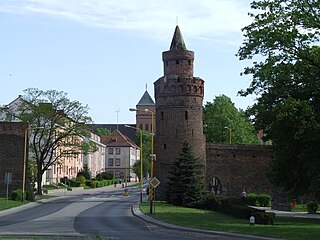
Pyrzyce, is a town in Pomerania, north-western Poland, with 13,331 inhabitants (2007).

The history of Pomerania starts shortly before 1000 AD with ongoing conquests by newly arrived Polans rulers. Before that, the area was recorded nearly 2000 years ago as Germania, and in modern-day times Pomerania is split between Germany and Poland. The name Pomerania comes from the Slavic po more, which means Land at the Sea.

Farther Pomerania, Hinder Pomerania, Rear Pomerania or Eastern Pomerania, is the part of Pomerania which comprised the eastern part of the Duchy and later Province of Pomerania. It stretched roughly from the Oder River in the West to Pomerelia in the East. Since 1945, Farther Pomerania has been part of Poland; the bulk of former Farther Pomerania is within the West Pomeranian Voivodeship, while its easternmost parts are within the Pomeranian Voivodeship. The Polish term Pomorze Zachodnie is colloquially used in contemporary Poland as a synonym for the West Pomeranian Voivodship whose borders do not match the historical ones; in Polish historical usage, it applied to all areas west of Pomerelia.

The Province of Pomerania was a province of Prussia from 1815 to 1945. Pomerania was established as a province of the Kingdom of Prussia in 1815, an expansion of the older Brandenburg-Prussia province of Pomerania, and then became part of the German Empire in 1871. From 1918, Pomerania was a province of the Free State of Prussia until it was dissolved in 1945 following World War II, and its territory divided between Poland and Allied-occupied Germany.

The Schlawe and Stolp Land, also known as Słupsk and Sławno Land, is a historical region in Pomerania, centered on the towns of Sławno (Schlawe) and Słupsk (Stolp) in Farther Pomerania, in present-day Poland.

History of Pomerania (1806–1933) covers the history of Pomerania from the early 19th century until the rise of Nazi Germany.

Głobino is a village in the administrative district of Gmina Słupsk, within Słupsk County, Pomeranian Voivodeship, in northern Poland. It lies approximately 6 kilometres (4 mi) south-east of Słupsk and 100 km (62 mi) west of the regional capital Gdańsk.

Krępa Słupska is a village in the administrative district of Gmina Słupsk, within Słupsk County, Pomeranian Voivodeship, in northern Poland. It lies approximately 6 kilometres (4 mi) south of Słupsk and 103 km (64 mi) west of the regional capital Gdańsk.

For other places with the same name, see Krzemienica.For the history of the region, see History of Pomerania.
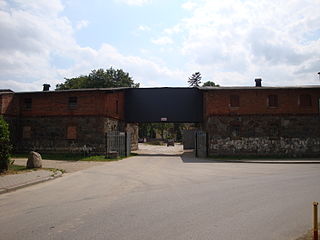
Kukowo is a village in the administrative district of Gmina Słupsk, within Słupsk County, Pomeranian Voivodeship, in northern Poland. It lies approximately 13 kilometres (8 mi) north-east of Słupsk and 97 km (60 mi) west of the regional capital Gdańsk.

Lubuczewo is a village in the administrative district of Gmina Słupsk, within Słupsk County, Pomeranian Voivodeship, in northern Poland. It lies approximately 8 kilometres (5 mi) north of Słupsk and 104 km (65 mi) west of the regional capital Gdańsk.
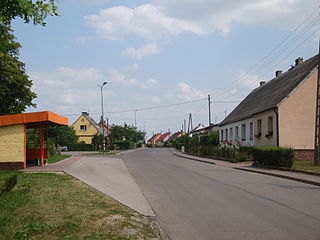
Rogawica is a village in the administrative district of Gmina Słupsk, within Słupsk County, Pomeranian Voivodeship, in northern Poland. It lies approximately 11 kilometres (7 mi) north-east of Słupsk and 97 km (60 mi) west of the regional capital Gdańsk.

Siemianice is a village in the administrative district of Gmina Słupsk, within Słupsk County, Pomeranian Voivodeship, in northern Poland. It lies approximately 5 kilometres (3 mi) north-east of Słupsk and 104 km (65 mi) west of the regional capital Gdańsk.
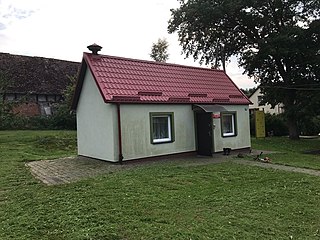
Strzelinko is a village in the administrative district of Gmina Słupsk, within Słupsk County, Pomeranian Voivodeship, in northern Poland. It lies approximately 8 kilometres (5 mi) north-west of Słupsk and 111 km (69 mi) west of the regional capital Gdańsk.

Wielichowo is a village in the administrative district of Gmina Słupsk, within Słupsk County, Pomeranian Voivodeship, in northern Poland. It lies approximately 10 kilometres (6 mi) north-west of Słupsk and 113 km (70 mi) west of the regional capital Gdańsk.
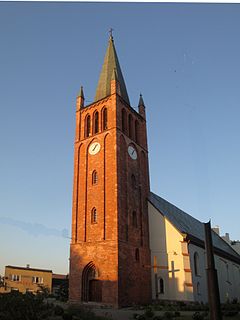
Gardna Wielka is a village in the administrative district of Gmina Smołdzino, within Słupsk County, Pomeranian Voivodeship, in northern Poland. It lies approximately 5 kilometres (3 mi) south-west of Smołdzino, 21 km (13 mi) north-east of Słupsk, and 100 km (62 mi) west of the regional capital Gdańsk.
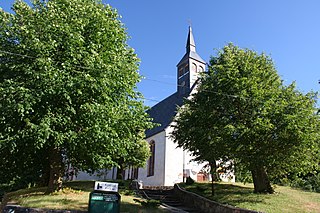
Smołdzino is a village in Słupsk County, Pomeranian Voivodeship, in northern Poland. It is the seat of the gmina called Gmina Smołdzino. It lies approximately 25 kilometres (16 mi) north-east of Słupsk and 98 km (61 mi) west of the regional capital Gdańsk.

Przebędowo is a village in the administrative district of Gmina Choczewo, within Wejherowo County, Pomeranian Voivodeship, in northern Poland. It lies approximately 4 kilometres (2 mi) south-west of Choczewo, 30 km (19 mi) north-west of Wejherowo, and 66 km (41 mi) north-west of the regional capital Gdańsk.
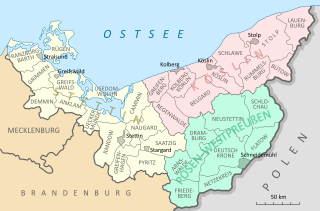
The Prussian Landkreis Regenwalde in Pomerania was a rural district that existed between 1818 and 1945.















